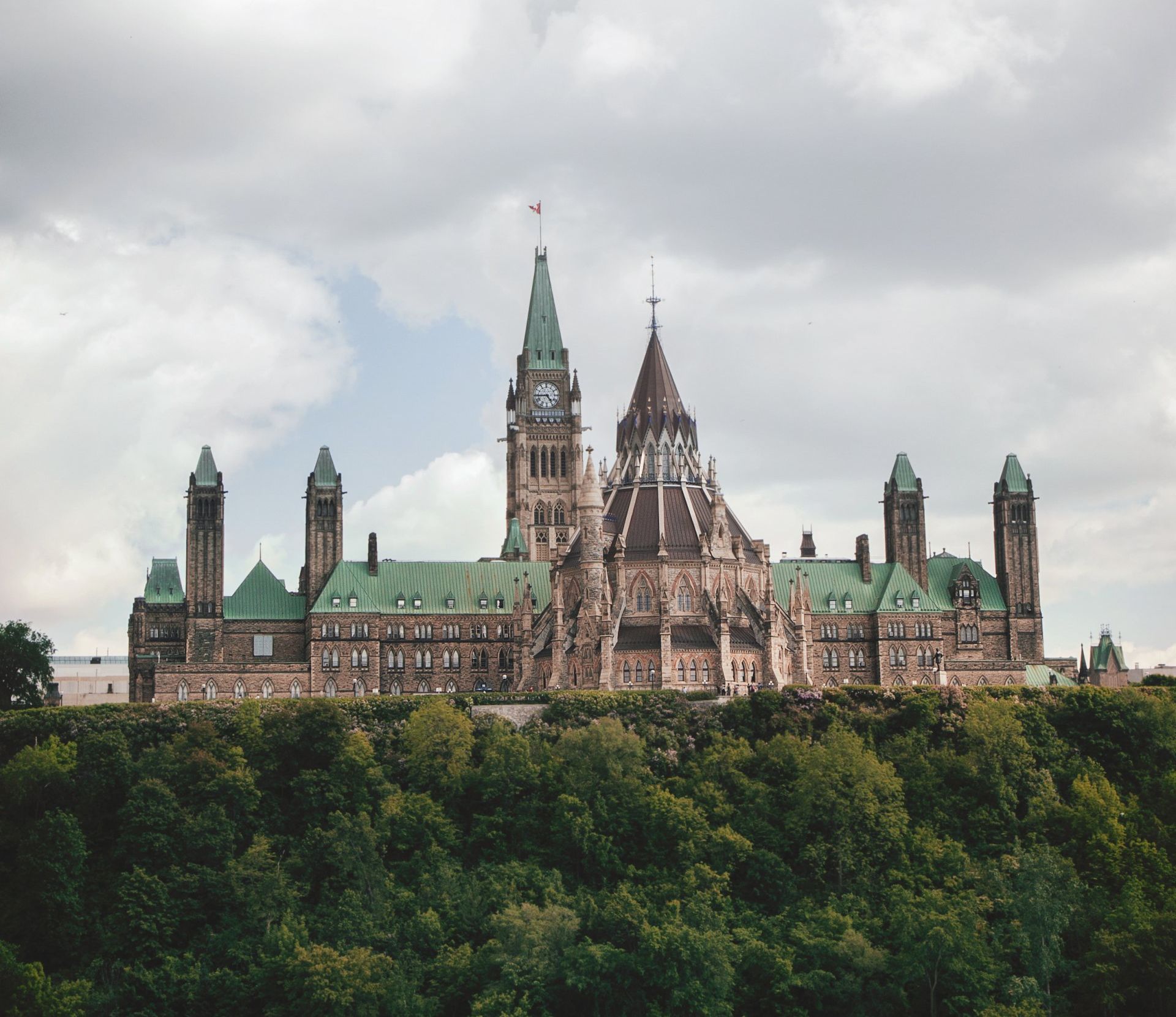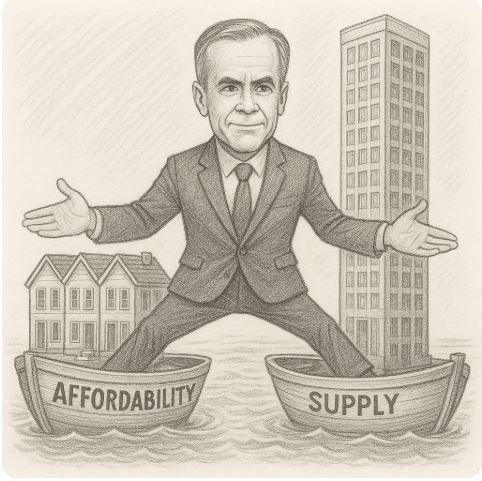Budget Beat: Insights for Real Estate Investors
In this edition of the Bird’s Eye View, we provide summaries and commentary on federal budget initiatives through the lens of private real estate investment. We focus on items that have seen less commentary from media, such as the potential freeze of development cost charge increases in communities over 300,000 population, and the Public Lands for Homes Plan, parts of the recently released Solving the Housing Crisis: Canada’s Housing Plan.

With the Canadian Federal Budget dropping on April 16th, there has been no shortage of commentary from news outlets and social media. The budget has not been well received (even by the younger demographic it purports to help, link to Leger poll), with much of the frustration directed at the increase to the Capital Gains Inclusion Rate and continued high spending and projected deficit ($39.8B).
In this edition of the Bird’s Eye View, we provide brief summaries and commentary on budget initiatives through the lens of private real estate investment. We focus on items that have seen less commentary from media, such as the potential freeze of development cost charge increases in communities with over 300,000 population, and the Public Lands for Homes Plan,
parts of the recently released Solving the Housing Crisis: Canada’s Housing Plan.
The Federal Budget
Before diving into the substance itself, we want to clarify a question we have seen going around, ‘Is the budget final’?
A: No, but yes.
When the budget is presented in the House of Commons, it functions as a notice of taxation and policy changes that the government will make, even though those changes haven’t yet been introduced or adopted by legislation.
Convention dictates that taxation proposals become effective when the budget is released, or on the dates stipulated in the budget, and the accompanying legislative amendments can be introduced at a later date (House of Commons Procedure and Practice).
After the initial motion (April 16, 2024), the budget process allows for a maximum of four additional sitting days of debate and any amendments before adoption. This means that potential amendments could still be made through early May, but historically, any amendments have only been minor in nature.
In short, while the nitty-gritty details haven’t been set down in legislation and there is still theoretical room for amendment, investors should treat the April 16th budget proposals as final and prepare accordingly.
Budget Proposals
With that out of the way, here is our take on a number of budget proposals that we think have a direct impact on private real estate investment:
1. Increase to Capital Gains Inclusion Rate
Summary: The capital gains inclusion rate has been raised from 50% to 66.7% for corporations, trusts and for individuals with capital gains over $250,000. Effective June 25, 2024.
Hawkeye Commentary:
More taxes…that’s the best way to inspire supply right? In truth though, we were expecting worse. To whatever extent this change may cool the Canadian investing climate, we anticipate that the impacts will be smaller for private equity real estate than stocks and direct real estate ownership.
Why? The income from development deals (and some private credit funds) is generally reported as active business income, not capital gains. Capital hates taxes, so this may make private equity real estate deals more attractive compared to alternatives.
However, while PERE may have dodged the bullet relative to certain other types of investment, there will still be secondary effects from this change. For example, a higher capital gains inclusion rate may affect the price that a purchaser is willing to pay for the rental assets of a Limited Partnership, which could affect deal returns, even if not directly.
Solving the Housing Crisis: Canada’s Housing Plan
Most of the proposals in the budget relevant to real estate fall under the scope of the recently released, “Solving the Housing Crisis: Canada’s Housing Plan”. The overarching goal of this plan is to see 3.87M new homes constructed by 2031, including a minimum of 2M homes over and above the 1.87M homes we are already on pace for by 2031.
In our view, there is no chance that this plan leads Canada to more than double the pace of housing development (this was echoed by Raymond Wong, Altus Group’s Vice President of Data Solutions in a
webinar we hosted on April 25th) but that doesn’t mean that the proposals themselves are bad, only that there are critical components still missing.
Let’s take a rapid fire look at several initiatives in this plan that the government is counting on to increase housing supply:
2. Accelerated Capital Cost Allowance
Summary:
The Capital Cost Allowance (CCA) for purpose-built rental buildings has been increased from 4% to 10%. The CCA system determines the deductions that a business may claim each year for income tax purposes. This allows depreciation deductions for purpose-built rentals to be spread across 10 years instead of 25, reducing income tax payable in those years. Applies to buildings that begin construction after April 16, 2024.
Hawkeye Commentary:
This is a positive development for supply, making development and ownership of rental assets more attractive. We are still trying to get a sense of how much this will affect project returns, but we suspect that this will at least partially offset the downside stemming from the increase to the Capital Gains Inclusion Rate.
3. Encouraging Municipalities to Freeze Development Cost Charges
Summary: The Federal Government will make a total of $5 Billion in funding available to provinces that commit to a list of items that will increase housing supply, three notable items include:
- “Implementing a 3-year freeze on increasing development charges from April 2, 2024 for municipalities with a population greater than 300,000.”
- Legalizing ‘missing-middle’ housing, to facilitate the development of up to 4 units on single family lots as-of-right (much as has already been done in BC).
- “Providing pre-approval for construction of designs included in the government’s upcoming Housing Design Catalogue”
Hawkeye Commentary:
This initiative has received very little attention, but it may be one of the most important for stimulating supply if this funding is sufficient to induce Province’s and Municipalities to come to agreements to freeze DCC’s. Take Vancouver for example, which is expecting to increase its Development Cost Levies on residential construction by over 20% beginning on September 30, 2024.
It appears that if BC wants a piece of that $5 Billion, those increases would need to be put on hold for 3 years. We are not privy to the inner-workings of municipal/provincial negotiations, but we suspect that there are discussions in the works that would see municipalities over 300,000 population receiving compensation in exchange for freezing Development Cost Charges.
4. 30-Year Mortgages for First-Time Buyers of New Homes
Summary: The government will now allow insured 30-year mortgages (up from 25 years) for first-time home buyers purchasing newly built homes, effective August 1st, 2024.
Hawkeye Commentary: We aren’t convinced that this initiative is going to do much to make housing more attainable (and thereby increase demand) in urban centres, though it may have more impact in rural areas.
Only new homes under $1M are insurable and would qualify for this program. In Metro Vancouver or Toronto, the price alone precludes everything but condos, with few exceptions. Seeing as most first home buyers aren’t likely to wait up to 2 years to get into their first home through a condo pre-sale, it feels like the market for this program might be limited. However, in areas where more housing types are available under $1M for new builds, this will likely see more use.
5. Home Buyer’s Plan
Summary:
Increases the Home Buyers’ Plan withdrawal limit from $35,000 to $60,000. The HBP allows individuals to make tax-free withdrawals from their RRSP to purchase or build their first home.
Hawkeye Commentary:
This is an admittedly minor change, but it makes good sense given the size of down payments required today. When combined with the increase to 30-year mortgage amortizations for first-time buyers of new product, this change will make ownership of a home more attainable for some.
6. Public Lands for Homes
Summary:
The Federal Government will conduct a review and make available surplus, underused, and vacant land for housing, with an intention to lease instead of sell. The initial plan is to focus on Canada Post, National Defence, and underused federal office properties.
Hawkeye Commentary:
The Federal Government is right that land availability is one of the critical missing components to providing affordable housing, and we were thrilled to see steps being taken to unlock public lands, but so far, we aren’t enthused with the program’s chosen direction.
First, the focus appears to be on previously developed, titled properties, as opposed to large tracts of undeveloped Crown land. The scope of the program proposed is so much more limited than it needs to be, but it’s a first step. Our best guess is that this first step is limited because it largely sidesteps First Nations title claims, which accompany most undeveloped Crown land.
Second, the model is focused on leasing land. From the information released, it isn’t perfectly clear how development will occur, but the rhetoric is leaning towards relying on non-profit and public housing to build out projects. If the goal is more, lower-cost housing, we aren’t convinced that governments becoming primary housing providers is the best value solution.
This will probably increase supply, though we aren’t convinced that we will see the 250,000 additional housing units projected.
7. Launching the Canada Build’s Program
Summary: Canada hit copy-paste on the BC Build’s program, bringing it national and encouraging other Provinces to adopt similar programs. It encourages more direct government provision of housing by providing funding and low-cost loans.
Hawkeye Commentary: We feel that if the cost of this program was instead used to further reduce municipal infrastructure development costs that are passed along to developers, it would result in much more housing than the government trying to develop directly. Instead, it appears that private developers will be forced to watch as governments skip to the front of development queues to deliver their own projects.
Conclusion
This budget isn’t ideal for facilitating real estate investment, though there are bright spots that had us both surprised and excited.
The Capital Gains Inclusion Rate increase hurts, and the budget as a whole does little to address some of the underlying issues preventing steady supply. In particular, ‘who is going to build the homes’? There is a small $10M investment in high school trades training and another $50M for foreign credential recognition to identify skilled trades workers for immigration programs, but these do little to address current construction limitations.
We also have a healthy level of skepticism around the government’s plans to directly provide housing, even if we are glad to see the first step being taken towards better utilizing Crown Lands.
The increase to the capital cost allowance for purpose-built rentals is a helpful addition, and if the Federal Government’s $5B fund is leveraged successfully to induce municipalities to freeze DCC rates, that would be hugely welcome news and a definite factor in increasing supply.
From a private real estate investment perspective, things could have been much better, though they also could have been much worse. There is enough here to believe that there will continue to be interesting investment opportunities on the horizon in Canada.
SUBSCRIBE TO THE BIRD'S EYE VIEW











